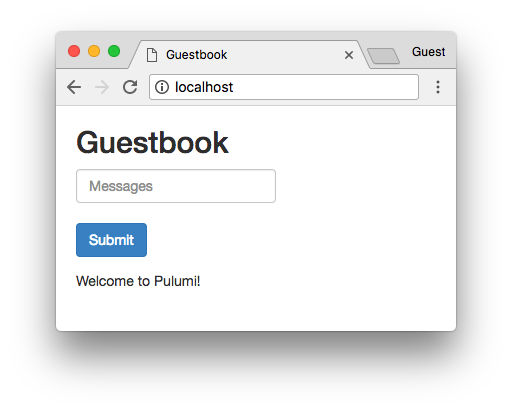Deploy Kubernetes and Applications with Go
Posted on
We’re excited that Go is now a first-class language in Pulumi and that you can build your infrastructure with Go on AWS, Azure, GCP, and many other clouds. Users often ask, “Can I use Pulumi to manage Kubernetes infrastructure in Go today?” With the release of Pulumi 2.0., the answer is “Yes!”
Building your Kubernetes infrastructure with Infrastructure as Code offers several benefits:
- Strongly-typed inputs and outputs for resources and invokes
- First-class language support in editors/IDEs like vim, VS Code, GoLand, and atom
- Reusable components and classes: Abstract standard functionality into classes and libraries for code reuse, and clean infrastructure design, instead of copy/pasting pages of YAML.
- Embed Pulumi programs within other Go-based tools
These benefits provide a productive experience for Go developers using Kubernetes.
Tour of Kubernetes with Go
Let’s start with a basic example, e.g. deploying an Nginx pod into a Kubernetes cluster.
pod, err := corev1.NewPod(ctx, "pod", &corev1.PodArgs{
Spec: corev1.PodSpecArgs{
Containers: corev1.ContainerArray{
corev1.ContainerArgs{
Name: pulumi.String("nginx"),
Image: pulumi.String("nginx"),
}
},
},
})
if err != nil {
return err
}
We can deploy this with pulumi up.
$ pulumi up
Previewing update (nginx):
Type Name Plan
+ pulumi:pulumi:Stack kubernetes-go-nginx create
+ └─ kubernetes:core:Pod pod create
Resources:
+ 2 to create
Do you want to perform this update? yes
Updating (nginx):
Type Name Status
+ pulumi:pulumi:Stack kubernetes-go-nginx created
+ └─ kubernetes:core:Pod pod created
Resources:
+ 2 created
Duration: 16s
Although programming languages are imperative, Pulumi describes the desired state of the infrastructure. If we change our program, Pulumi will compute the minimum delta and apply it to our Kubernetes cluster, which will transition to the new desired state. For example, we can modify our Kubernetes resources in place inside the cluster by adding a label to our Pod:
pod, err := corev1.NewPod(ctx, "pod", &corev1.PodArgs{
+ Metadata: &metav1.ObjectMetaArgs{
+ Labels: pulumi.StringMap{"app": pulumi.String("nginx")},
+ },
Spec: corev1.PodSpecArgs{
Containers: corev1.ContainerArray{
corev1.ContainerArgs{
Name: pulumi.String("nginx"),
Image: pulumi.String("nginx"),
}},
},
})
if err != nil {
return err
}
When we update the deployment with ‘pulumi up`, the preview shows that the pod is updated in place with the new label.
$ pulumi up
Previewing update (nginx):
Type Name Plan Info
pulumi:pulumi:Stack kubernetes-go-nginx
~ └─ kubernetes:core:Pod pod update [diff: ~metadata]
Resources:
~ 1 to update
1 unchanged
Do you want to perform this update? details
pulumi:pulumi:Stack: (same)
[urn=urn:pulumi:nginx::kubernetes-go::pulumi:pulumi:Stack::kubernetes-go-nginx]
~ kubernetes:core/v1:Pod: (update)
[id=default/pod-yxmgq7q2]
[urn=urn:pulumi:nginx::kubernetes-go::kubernetes:core/v1:Pod::pod]
~ metadata: {
~ labels: {
+ app: "nginx"
}
}
Do you want to perform this update? yes
Updating (nginx):
Type Name Status Info
pulumi:pulumi:Stack kubernetes-go-nginx
~ └─ kubernetes:core:Pod pod updated [diff: ~metadata]
Resources:
~ 1 updated
1 unchanged
Duration: 13s
The benefits of Go start to shine when we extract common code into a reusable component. For example, we can create a new ServiceDeployment component that combines both a Kubernetes Service and Deployment with opinionated defaults. Our ServiceDeployment component can describe entire Kubernetes applications (100s of lines of YAML), in a short snippet of Go:
// Initialize config
conf := config.New(ctx, "")
// Minikube does not implement services of type `LoadBalancer` so
// require the user to specify if we're running on minikube. If so,
// create only services of type ClusterIP.
isMinikube := conf.GetBool("isMinikube")
// Redis leader Deployment + Service
_, err := NewServiceDeployment(ctx, "redis-master", &ServiceDeploymentArgs{
Image: pulumi.String("k8s.gcr.io/redis:e2e"),
Ports: pulumi.IntArray{pulumi.Int(6379)},
})
if err != nil {
return err
}
// Redis follower Deployment + Service
_, err = NewServiceDeployment(ctx, "redis-slave", &ServiceDeploymentArgs{
Image: pulumi.String("gcr.io/google_samples/gb-redisslave:v3"),
Ports: pulumi.IntArray{pulumi.Int(6379)},
})
if err != nil {
return err
}
// Frontend Deployment + Service
frontend, err := NewServiceDeployment(ctx, "frontend", &ServiceDeploymentArgs{
AllocateIPAddress: true,
Image: pulumi.String("gcr.io/google-samples/gb-frontend:v4"),
IsMinikube: pulumi.Bool(isMinikube),
Ports: pulumi.IntArray{pulumi.Int(80)},
Replicas: pulumi.Int(3),
})
if err != nil {
return err
}
if isMinikube {
ctx.Export("frontendIP", frontend.Service.Spec.ApplyT(
func(spec *corev1.ServiceSpec) *string { return spec.ClusterIP }))
} else {
ctx.Export("frontendIP", frontend.FrontendIP)
}
The complete implementation of the ServiceDeployment component is detailed in the Guestbook example in the Pulumi Examples repo on GitHub.

Building Docker Images for Kubernetes with Go
In the previous examples, we specified the Docker image to deploy as part of our Kubernetes Deployments by referring to an image in a registry. If we wanted to push our custom Docker image that uses our application’s source code, and deploy that in our Kubernetes Pod or Deployment, we can do it with the pulumi-docker package. For example, we can deploy our custom Nginx Docker image with the following:
image, err := docker.NewImage(ctx, "node-app", &docker.ImageArgs{
ImageName: pulumi.String("my-username/my-nginx"),
Build: &docker.DockerBuildArgs{
Context: pulumi.String("./app"),
},
})
if err != nil {
return err
}
pod, err := corev1.NewPod(ctx, "pod", &corev1.PodArgs{
Metadata: &metav1.ObjectMetaArgs{
Labels: pulumi.StringMap{"app": pulumi.String("nginx")},
},
Spec: corev1.PodSpecArgs{
Containers: corev1.ContainerArray{
corev1.ContainerArgs{
Name: pulumi.String("nginx"),
Image: image.ImageName,
}},
},
})
if err != nil {
return err
}
We can use our Dockerfile from the app folder in our Pulumi project, instead of using the default Nginx image from DockerHub. For example, adding the following in our Dockerfile deploys customized files in the app/content folder to our Nginx server:
FROM nginx
COPY content /usr/share/nginx/html
When we deploy this with Pulumi, the Dockerfile is built locally, pushed to a registry, then made available by specifying the image name in the registry referenced from the Pod in Kubernetes. Our changes happen automatically, seamlessly deploying and versioning both the application code and infrastructure together with a simple pulumi up.
We can also push to another Docker container registry (like ACR, GCR, ECR, or others) by using additional parameters on the pulumi.docker.ImageArgs class.
Cloud + Kubernetes with Go
Pulumi works with both Kubernetes and cloud providers (AWS, Azure, GCP, and more.) Within the same Pulumi program, you can build a Kubernetes cluster and then deploy applications and services into that cluster.
For example, we can deploy a managed GKE cluster, and then deploy a Pod into it:
masterVersion := "1.14.10-gke.27"
cluster, err := container.NewCluster(ctx, "demo-cluster", &container.ClusterArgs{
InitialNodeCount: pulumi.Int(2),
MinMasterVersion: pulumi.String(masterVersion),
NodeVersion: pulumi.String(masterVersion),
NodeConfig: &container.ClusterNodeConfigArgs{
MachineType: pulumi.String("n1-standard-1"),
OauthScopes: pulumi.StringArray{
pulumi.String("https://www.googleapis.com/auth/compute"),
pulumi.String("https://www.googleapis.com/auth/devstorage.read_only"),
pulumi.String("https://www.googleapis.com/auth/logging.write"),
pulumi.String("https://www.googleapis.com/auth/monitoring"),
},
},
})
if err != nil {
return err
}
ctx.Export("kubeconfig", generateKubeconfig(
cluster.Endpoint, cluster.Name, cluster.MasterAuth))
k8sProvider, err := providers.NewProvider(
ctx, "k8sprovider", &providers.ProviderArgs{
Kubeconfig: generateKubeconfig(
cluster.Endpoint, cluster.Name, cluster.MasterAuth),
}, pulumi.DependsOn([]pulumi.Resource{cluster}))
if err != nil {
return err
}
namespace, err := corev1.NewNamespace(ctx, "app-ns", &corev1.NamespaceArgs{
Metadata: &metav1.ObjectMetaArgs{
Name: pulumi.String("demo-ns"),
},
}, pulumi.Provider(k8sProvider))
if err != nil {
return err
}
appLabels := pulumi.StringMap{
"app": pulumi.String("demo-app"),
}
_, err = appsv1.NewDeployment(ctx, "app-dep", &appsv1.DeploymentArgs{
Metadata: &metav1.ObjectMetaArgs{
Namespace: namespace.Metadata.Elem().Name(),
},
Spec: appsv1.DeploymentSpecArgs{
Selector: &metav1.LabelSelectorArgs{
MatchLabels: appLabels,
},
Replicas: pulumi.Int(3),
Template: &corev1.PodTemplateSpecArgs{
Metadata: &metav1.ObjectMetaArgs{
Labels: appLabels,
},
Spec: &corev1.PodSpecArgs{
Containers: corev1.ContainerArray{
corev1.ContainerArgs{
Name: pulumi.String("demo-app"),
Image: pulumi.String("jocatalin/kubernetes-bootcamp:v2"),
}},
},
},
},
}, pulumi.Provider(k8sProvider))
if err != nil {
return err
}
This example first deploys a GKE Kubernetes Cluster into GCP, then deploys Kubernetes resources into that GKE Cluster. This example combines infrastructure and application deployment in a few dozen lines of declarative and strongly typed Go code.
Check out the full GKE in Go example on GitHub.
Conclusion
Kubernetes support is one of several significant new additions made available to Pulumi’s Go community and more improvements are on the way. Get started with Kubernetes and Go today, and let us know what you think!

